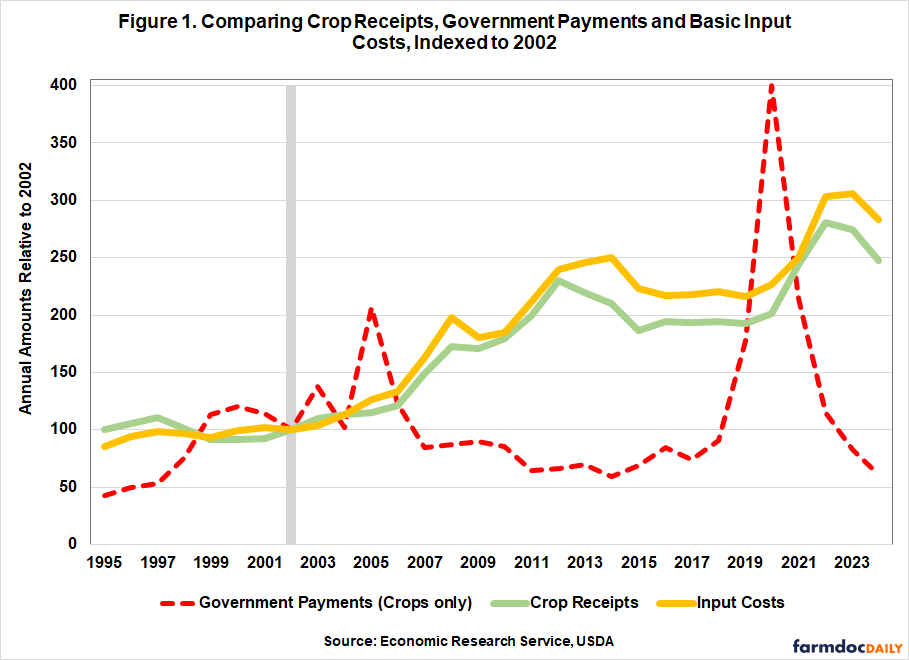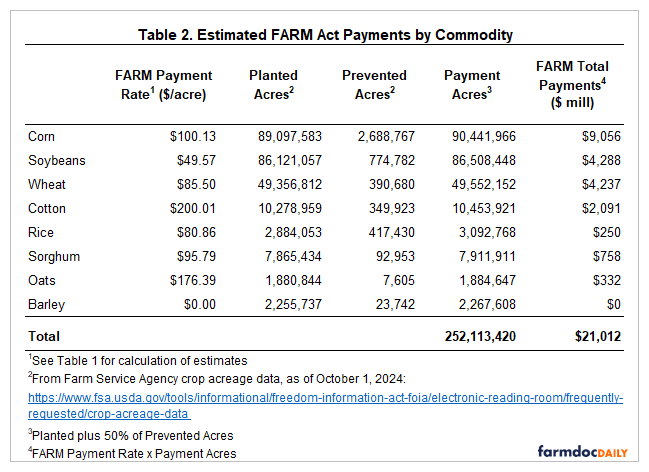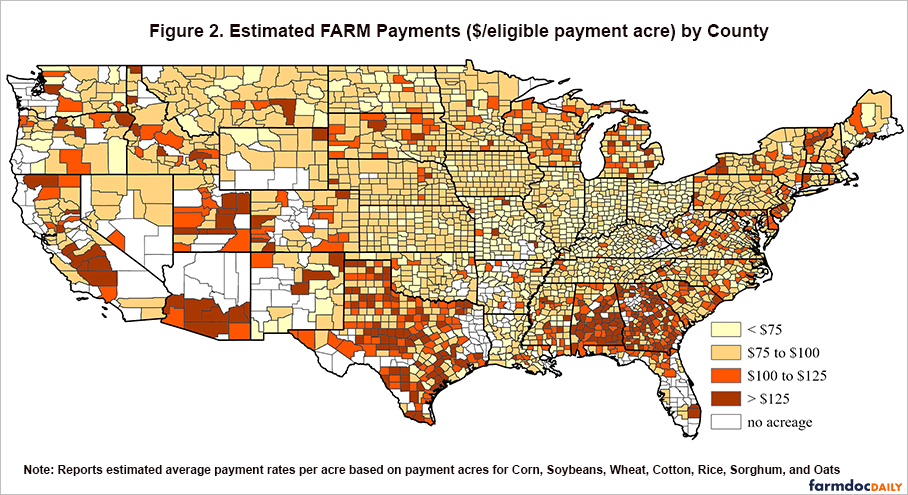Reviewing the Latest Ad Hoc Payment Proposal in Congress
Since the tariff and trade conflicts that began in 2018, through the pandemic relief assistance efforts in 2020, American farmers have received an unusual amount of ad hoc and supplemental or emergency assistance (see e.g., farmdoc daily, April 18, 2018; July 31, 2018; August 16, 2018; August 28, 2018; May 22, 2020; July 10, 2020; September 3, 2020; June 6, 2022; April 5, 2023). From 2018 to 2023, USDA reports a total of $77.8 billion in ad hoc and supplemental assistance to farmers, along with another $14.5 billion in non-USDA pandemic assistance (see, USDA-ERS, September 5, 2024). On October 25, 2024, Representative Trent Kelly (R-MS) introduced legislation to provide a new round of ad hoc economic assistance payments to farmers of selected crops for 2024 (H.R. 10045; see also, Kramer, October 22, 2024; ProAg.com, October 23, 2024). This article reviews the latest proposal and raises further questions about its implications (see e.g., farmdoc daily, July 29, 2020; October 30, 2024).
Background
As previously discussed, crop prices will be lower for crops produced in 2024 than in recent years generally because of growth in total supply from expanded acres in South America and overall good yields in the United States (see e.g., farmdoc daily, October 16, 2024; October 8, 2024; October 7, 2024; September 24, 2024; September 10, 2024; September 9, 2024; August 19, 2024; July 30, 2024). When coupled with continued high input costs (e.g., seeds, fertilizer, chemical pesticides, and fuel, as well as cash rent), the result can cause a squeeze for farmers between lower expected revenues against those higher costs (see e.g., farmdoc daily, September 26, 2024). At the same time, farm payment programs (Agriculture Risk Coverage (ARC) and Price Loss Coverage (PLC)) are not expected to trigger payments to many farmers because crop prices were relatively high in recent years (see e.g., farmdoc daily, October 29, 2024; October 22, 2024). In general, these matters form the core of the premise behind the ad hoc proposal.
The current situation presents a new twist on what are generally historical challenges between crop prices, incomes, and costs. The anomalous situation since 2018 has been the unprecedented payments made in addition to traditional farm program payments. Figure 1 provides a background perspective using the national level nominal data from ERS (USDA-ERS, Farm Income and Wealth Statistics). Each year reported by ERS is presented relative to 2002 and the 2002 Farm Bill, tracing back to 1995, prior to enactment of the 1996 Farm Bill. Figure 1 provides a national level perspective spanning the last five farm bills.
Discussion
The ad hoc proposal is titled: Farmer Assistance and Revenue Mitigation Act of 2024, or FARM Act (H.R. 10045). It seeks to provide “economic assistance payments” for the current, 2024 crop year for “expected gross return per acre” that is less than “expected cost of production per acre” (H.R. 10045). The legislation defines eligible commodities to include all covered commodities in the Farm Bill and specifies that cotton includes both extra-long staple and seed cotton (see 7 U.S.C. §9011). Notably, payments use a calculation that is only applicable to the eight listed commodities (corn, soybeans, wheat, cotton, rice, sorghum, oats, and barley). It adds that all other covered commodities not listed are to receive a “comparable estimate of total production costs” and “gross returns” (H.R. 10045). That calculation is as follows:
-
- Expected Gross Return Per Acre = the projected average farm price for the 2024-2025 marketing year as reported by USDA in the World Agricultural Supply and Demand Estimates (WASDE), multiplied by the 10-year average national average harvested yield per acre.
- Expected Cost of Production Per Acre = based on the most recent costs forecast by USDA, ERS for the eight listed crops (USDA, ERS: Commodity Costs and Returns).
- Economic Loss = Expected Cost of Production minus Expected Gross Return.
- Payment Amount = 60% of the Economic Loss multiplied by the eligible acres on the farm.
- Eligible Acres = acreage planted to the eligible commodities in 2024, plus 50% of the acres prevented from planting in 2024 (presumably as reported to the Farm Service Agency).
Notable in this calculation is the use of a 10-year average national yields instead of the expected or forecast yields (or actual when they are available) for the 2024 crop year, which is the year used for everything else and for which the economic assistance is intended to cover. For most crops the 10-year average would be lower than the expected yields for 2024, which would reduce gross return and increase payments. Cotton appears to be the exception in which the 10-year average is higher than the current 2024 projection. The calculation also uses the total economic cost of production for these crops, which includes costs for some crops like cotton (ginning) that is not included for other crops. As discussed previously, this would have the effect of increasing the expected cost per acre for those crops and thereby increasing the payment amount for them (see e.g., farmdoc daily, June 28, 2023; September 22, 2022; March 8, 2018). Table 1 provides estimated payment rates for each of the listed crops.
The bill would create a special payment limit provision for these payments, another break from historic precedent. If an individual or entity (except for joint ventures or general partnerships) receives less than 75% of its average gross income (2020-2022 tax years) from farming, ranching, or silviculture activities then the payment limit is $175,000; if the individual or entity (except for joint ventures or general partnerships) receives 75% or more of its average gross income (2020-2022 tax years) from farming, ranching or silviculture, then the limit is $350,000. If enacted, this would be the first instance in which Congress explicitly differentiated payment limits by the size of the farm, although an earlier program created by USDA (WHIP) included a similar version. The proposed limits would also provide for higher limits for larger farms than previous assistance programs enacted by Congress, all which is contrary to the traditional policy intent of limiting large payments to large farms.”[1]
The economic assistance is to be paid out of the funds of the Commodity Credit Corporation (CCC) and the payments are to receive an emergency designation to avoid being subject to budget rules and disciplines such as pay-as-you-go (PAYGO) restrictions and offset requirements. Table 2 provides estimated spending on payments for the eight listed commodities. Payments for other eligible commodities not listed are not included in this table but would add to the overall cost of the proposed assistance.
Finally, Figure 2 provides a map of estimated FARM payments for the eight listed crops per eligible acre by county. County-level per acre payments shown in Figure 2 are averages, weighted by eligible acres, of the estimated payment rates by commodity reported in Table 1. Thus, the highest average payment rates tend to be concentrated in the areas where the crops with the highest estimated payment rates were planted (or prevented) in 2024. This includes counties in the southern US that produce cotton and, to a lesser extent, counties in the northern US that produce oats.
Concluding Thoughts
The FARM Act, introduced on October 25, 2024, proposes payments to selected commodities based on concerns about economic losses associated with the cost-price squeeze currently facing US crop producers. For the major commodities with a specified payment rate calculation outlined in the proposed legislation, we estimate the FARM Act would result in at least $21 billion in ad hoc support payments to farmers.
The sheer size of the proposed support payments present significant hurdles to the FARM Act becoming law as proposed. The estimated cost of $21 billion is more than the entire baseline for ARC-CO over ten years, or more than seven years of PLC baseline. Moreover, the $350,000 payment limit that can be doubled with a spouse or multiplied for every partner in a general partnership, could also present significant political barriers. Given that the proposal would need to be enacted in an expected lame duck session of Congress, such barriers could prove insurmountable because that session must deal with remaining appropriations and other disaster relief efforts. Controversial elements like the overall cost or the payment limits are likely to result in significant changes to the proposal, or its outright exclusion.
While the proposed FARM Act payments would provide payments to crop producers in the short-run, concerns over the longer-term impacts on agriculture should be considered. Market signals suggest that commodity prices could remain at current levels for the 2025 and into the 2026 crop years. If this occurs, further cost adjustments will be needed to generate viable returns for farmers; providing assistance at this scale will reduce market pressures needed to achieve those cost reductions.
A potential worst-case outcome for producers is that the Act ultimately does not pass, or passes in a modified form with much lower levels of support, due to the previously discussed political hurdles and results in another year of costs remaining at elevated levels based on the expectation of support as proposed. Based on the potential for this outcome, farmers, landowners, lenders, and input supplies should use caution in how they consider the proposed FARM Act in making decisions for the 2025 crop year.
Finally, the FARM Act could also be interpreted as an acknowledgement that current farm policy is not working or has too many holes and other problems that need to be fixed (see e.g., farmdoc daily, October 30, 2024). Its consideration in a lame duck session likely precludes reauthorization of the Farm Bill, kicking the implications of that acknowledgement into a new year and a new Congress.
Editorial Note: [1] This sentence has been revised to clarify this issue. The Wildfires and Hurricanes Indemnity Program (WHIP) was created by USDA in 2018 using funds from the Bipartisan Budget Act of 2018 (P.L. 115-123). The regulation included a similar split payment limit, while the legislation was silent on the matter. USDA did not spend all of the funds and Congress repurposed the remaining funds for WHIP+ in 2019 (P.L. 116-94). That legislation incorporated the earlier WHIP regulation by reference but was otherwise silent on the specific issue of payment limits, which would likely be interpreted as ratification of the regulation (including the payment limit) by Congress if it were challenged (see also, Stubbs, May 7, 2020).
References
Burak, S., K. Baylis, J. Coppess and Q. Xie. "A Looming Trade War – An Illinois Ag Perspective." farmdoc daily (8):69, Department of Agricultural and Consumer Economics, University of Illinois at Urbana-Champaign, April 18, 2018.
Coppess, J., N. Paulson and G. and Carl Zulauf. "Farm Bill Review: Historic Fixed Price Policy and Costs of Production." farmdoc daily (8):41, Department of Agricultural and Consumer Economics, University of Illinois at Urbana-Champaign, March 8, 2018.
Coppess, J., J. Janzen, K. Swanson, N. Paulson, C. Zulauf and G. Schnitkey. "Mulling Over Margin, Part 2: the “Elusive” Cost of Production." farmdoc daily (12):146, Department of Agricultural and Consumer Economics, University of Illinois at Urbana-Champaign, September 22, 2022.
Coppess, J. "Squeezing the Farmer, Part 1: Initiating Examination of a Persistent Challenge." farmdoc daily (14):175, Department of Agricultural and Consumer Economics, University of Illinois at Urbana-Champaign, September 26, 2024.
Franken, J. and J. Janzen. "Insights for Supply, Ending Stocks, and Prices from FSA Acreage Data." farmdoc daily (14):152, Department of Agricultural and Consumer Economics, University of Illinois at Urbana-Champaign, August 19, 2024.
Janzen, J. "A Breath of Optimism for Corn in a Down Market." farmdoc daily (14):182, Department of Agricultural and Consumer Economics, University of Illinois at Urbana-Champaign, October 7, 2024.
Janzen, J. "Post-Harvest Grain Marketing in a Low-Price Environment." farmdoc daily (14):163, Department of Agricultural and Consumer Economics, University of Illinois at Urbana-Champaign, September 9, 2024.
Janzen, J., J. Coppess and N. Paulson. "CFAP Payments to Date and Possible Future Ad Hoc Farm Payments." farmdoc daily (10):160, Department of Agricultural and Consumer Economics, University of Illinois at Urbana-Champaign, September 3, 2020.
Kramer, Cheyenne. “Everything Farmers Need to Know About The FARM Act in Congress.” Agweb.com. October 22, 2024. https://www.agweb.com/news/crops/crop-production/everything-farmers-need-know-about-farm-act-congress.
Paulson, N., G. Schnitkey, C. Zulauf, J. Coppess "2023 ARC-CO and PLC Payments for Corn, Soybeans, and Wheat." farmdoc daily (14):196, Department of Agricultural and Consumer Economics, University of Illinois at Urbana-Champaign, October 29, 2024.
Paulson, N., G. Schnitkey, B. Zwilling and C. Zulauf. "2025 Illinois Crop Budgets." farmdoc daily (14):173, Department of Agricultural and Consumer Economics, University of Illinois at Urbana-Champaign, September 24, 2024.
Paulson, N., G. Schnitkey, J. Coppess, C. Zulauf and K. Swanson. "Coronavirus Food Assistance Program (CFAP) Rules Announced." farmdoc daily (10):95, Department of Agricultural and Consumer Economics, University of Illinois at Urbana-Champaign, May 22, 2020.
ProAg. “FARM Act Introduced to Congress to Offset Financial Pressure.” ProAg.com, October 23, 2024. https://www.proag.com/news/farm-act-introduced-to-congress-to-offset-financial-pressure/.
Schnitkey, G., J. Coppess, C. Zulauf and N. Paulson. "Potential Federal Policy Responses to Negative Grain Farm Incomes." farmdoc daily (14):192, Department of Agricultural and Consumer Economics, University of Illinois at Urbana-Champaign, October 22, 2024.
Schnitkey, G., B. Zwilling, N. Paulson, C. Zulauf, B. Rhea and J. Baltz. "Increasing Pessimism About 2024 and 2025 Corn and Soybean Returns." farmdoc daily (14):141, Department of Agricultural and Consumer Economics, University of Illinois at Urbana-Champaign, July 30, 2024.
Schnitkey, G., N. Paulson and C. Zulauf. "2024 Low Returns, Prices, and the Federal Safety Net." farmdoc daily (14):164, Department of Agricultural and Consumer Economics, University of Illinois at Urbana-Champaign, September 10, 2024.
Schnitkey, G., N. Paulson, B. Zwilling, B. Goodrich, C. Zulauf and J. Baltz. "Perspectives and Strategies for Dealing with Low Farm Incomes in 2024 and Beyond." farmdoc daily (14):183, Department of Agricultural and Consumer Economics, University of Illinois at Urbana-Champaign, October 8, 2024.
Schnitkey, G., K. Swanson, J. Coppess, N. Paulson and C. Zulauf. "MFP and CFAP Payments, Corn and Soybean Uses, and Future Farm Profitability." farmdoc daily (10):106, Department of Agricultural and Consumer Economics, University of Illinois at Urbana-Champaign, June 10, 2020.
Swanson, K., G. Schnitkey, C. Zulauf, J. Coppess and N. Paulson. "The Continuation of Disaster Programs in U.S. Agriculture: Emergency Relief Program." farmdoc daily (12):83, Department of Agricultural and Consumer Economics, University of Illinois at Urbana-Champaign, June 6, 2022.
Swanson, K., J. Coppess and G. Schnitkey. "Trade Timeline and Corn and Soybean Prices." farmdoc daily (8):141, Department of Agricultural and Consumer Economics, University of Illinois at Urbana-Champaign, July 31, 2018.
Zulauf, C., J. Coppess, G. Schnitkey and N. Paulson. "Cost of Production and Farm Policy, Part II: Statutory Reference Prices." farmdoc daily (13):118, Department of Agricultural and Consumer Economics, University of Illinois at Urbana-Champaign, June 28, 2023.
Zulauf, C. "Net Return to Farm Program Crops: Harvest 2024." farmdoc daily (14):189, Department of Agricultural and Consumer Economics, University of Illinois at Urbana-Champaign, October 16, 2024.
Zulauf, C., N. Paulson and G. Schnitkey. "Farm Payments by Programs other than Commodity Programs and Crop Insurance: Third Pillar of the US Farm Safety Net." farmdoc daily (13):63, Department of Agricultural and Consumer Economics, University of Illinois at Urbana-Champaign, April 5, 2023.
Zulauf, C., J. Coppess, N. Paulson and G. Schnitkey. "The Tariff Conflict and Change in Value of Production of U.S. Field Crops." farmdoc daily (8):153, Department of Agricultural and Consumer Economics, University of Illinois at Urbana-Champaign, August 16, 2018.
Zulauf, C., G. Schnitkey, J. Coppess, N. Paulson and K. Swanson. "Ad Hoc Payments: A Leading Indicator of Farm Policy Change." farmdoc daily (10):140, Department of Agricultural and Consumer Economics, University of Illinois at Urbana-Champaign, July 29, 2020
Zulauf, C., G. Schnitkey, J. Coppess and N. Paulson. "Fixing Holes in the Current Crop Safety Net." farmdoc daily (14):197, Department of Agricultural and Consumer Economics, University of Illinois at Urbana-Champaign, October 30, 2024.
Disclaimer: We request all readers, electronic media and others follow our citation guidelines when re-posting articles from farmdoc daily. Guidelines are available here. The farmdoc daily website falls under University of Illinois copyright and intellectual property rights. For a detailed statement, please see the University of Illinois Copyright Information and Policies here.











